
The America's Cup, informally known as the Auld Mug, is a trophy awarded in the sport of sailing. It is the oldest international competition still operating in any sport. America's Cup match races are held between two sailing yachts: one from the yacht club that currently holds the trophy and the other from the yacht club that is challenging for the cup. There is no fixed schedule, with matches held several years apart on dates agreed between the defender and the challenger. The most recent America's Cup match took place in March 2021.

Nathanael Greene Herreshoff was an American naval architect, mechanical engineer, and yacht design innovator. He produced a succession of undefeated America's Cup defenders between 1893 and 1920.

America was a 19th-century racing yacht and first winner of the America's Cup international sailing trophy.

Vigilant was the victorious United States defender of the eighth America's Cup in 1893 against British challenger Valkyrie II. Vigilant was designed by Nathanael Greene Herreshoff and built in 1893 by the Herreshoff Manufacturing Company of Bristol, Rhode Island. She was Herreshoff's first victorious America's Cup defender design.

Mayflower was the victorious U.S. defender of the sixth America's Cup in 1886 against Scottish challenger Galatea.
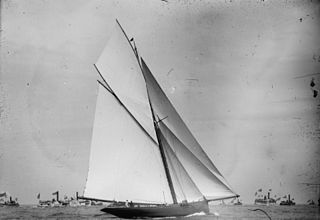
Genesta was the unsuccessful English challenger in the fifth America's Cup in 1885 against the American defender Puritan.

Thistle was the unsuccessful Scottish challenger of the seventh America's Cup in 1887 against American defender Volunteer.

Volunteer was an American racing yacht built in 1887 for the America's Cup races. She was the victorious American defender of the seventh America's Cup match that same year against Scottish challenger Thistle.

Edward Burgess (1848–1891) was an American yacht designer. Several of his boats won fame in the waters of the eastern United States.

George Lawley & Son was a shipbuilding firm operating in Massachusetts from 1866 to 1945. It began in Scituate, then moved to Boston. After founder George Lawley (1823–1915) retired in 1890, his son, grandson and great-grandson upheld the business, which continued until 1945. Of the hundreds of ships built by the Lawleys, highlights include the yachts Puritan and Mayflower, respective winners of the 1885 and 1886 America's Cup.

The Sylph was a 19th-century pilot boat first built in 1834, by Whitmore & Holbrook for John Perkins Cushing as a Boston yacht and pilot-boat for merchant and ship owner Robert Bennet Forbes. She won the first recorded American yacht race in 1835. She was a pilot boat in the Boston Harbor in 1836 and 1837 and sold to the New York and Sandy Hook Pilots in October 1837. She was lost in winter of 1857 with all hands during a blizzard off Barnegat, New Jersey. The second Sylph was built in 1865 from a half-model by Dennison J. Lawlor. The third Sylph was built in 1878 at North Weymouth, Massachusetts for Boston Pilots. She was sold out of service in 1901, after 23 years of Boston pilot service.
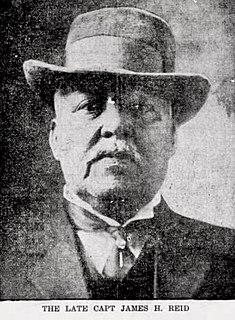
James H. Reid, was a 19th-century American Maritime pilot. He is best known for being the dean of the Boston pilots, serving for 55 years. He was captain of the famous yacht America for 17 years when she was owned by Benjamin F. Butler. In 1897, he built a new America, named after the America's Cup defender.
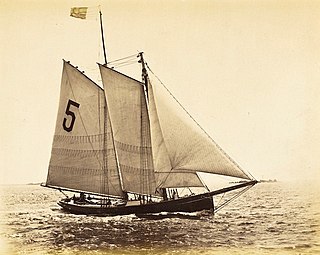
The Hesper was a 19th-century Boston pilot boat built in 1884, designed from a model by Dennison J. Lawlor as a Boston yacht and pilot-boat for merchant and ship owner George W. Lawler. She was known to be the largest pilot boat under the American flag at 104 feet long and the fastest of the Boston fleet. She competed in several first-class sailing races, and in 1886, the Hesper won the silver cup in what was known as the first Fishermen's Race. She was withdrawn from the pilot service and sold in 1901. The Hesper became a wreck on the point off Cape Henlopen in 1919.
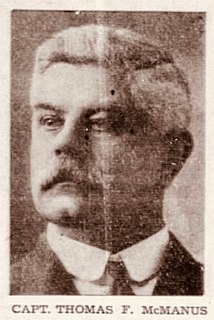
Thomas Francis McManus was a fish merchant who became a naval architect, responsible for introducing the shortened bowsprit and long stern overhang to give speed to his vessels. He was well known for revolutionizing the Gloucester fishing schooner. He made the fastest vessels of their type in the world and was honored on two continents for his skill as a naval architect. He became known as the "Father of the Fishermen's Races." 500 fishing schooners used his designs to improve speed. He was a friend of Sir Thomas Lipton and President Theodore Roosevelt.

The Adams was a 19th-century Boston pilot boat, built in 1888 by Moses Adams at Essex, Massachusetts for Captain John H. Jeffries. She was named for Melvin O. Adams, an American attorney and railroad executive. Her design was by yacht designer Edward Burgess, known for his America's Cup defenders. In 1901, she was one of only five pilot-boats left in the Boston fleet. In 1901, she was sold and landed in the Portuguese immigrant trade. She was sunk by enemy action during World War I.

The Varuna was a 19th-century Boston pilot boat, built by Montgomery & Howard at Chelsea, Massachusetts in 1890, for a group of Boston pilots. She was designed by yacht designer Edward Burgess, known for his America's Cup defenders. She was the first centerboard pilot-boat in operation in the Massachusetts Bay. The Varuna went out of service in 1912 because of the introduction of steam power into pilot-boats. She was later sold to Stephen Simmons to be used as a trading vessel between ports in the Spanish Main in 1913.

The Trenton was an auxiliary motor pilot boat built in Essex County, Massachusetts for a company of New Jersey Sandy Hook pilots in 1907. She was formerly the fishing schooner Kernwood, designed by Thomas F. McManus of Boston in 1904. As a pilot boat, she spent twenty-five years in pilot service before being placed out of service in 1934.
Dennison J. Lawlor, was a 19th-century Canadian-Irish shipbuilder and yacht designer. He apprenticed under shipbuilder Whitmore & Holbrook. Lawlor had his own shipyard, building and designing for 40 years some of the finest yachts, pilot boats, and 150 merchant vessels built from his designs. The most notable were the Hesper, Florence, and D. J. Lawlor. Lawlor died in Chelsea, Massachusetts in 1892.
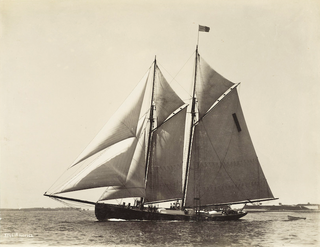
The America, No. 1 was a 19th-century American pilot boat built in 1897 for Captain James H. Reid, Sr., of Boston and designed by Boston designer Thomas F. McManus. The Boston America did not resemble her famous namesake, yacht America, rather she was designed with a fishing schooner "Indian header" bow. After serving 21 years in the Boston Pilots' Association, the America was sold to David W. Simpson of Boston in 1918.

The Gracie was a 19th-century racing sloop yacht built in 1868 by James E. Smith shipyard at Nyack, New York. She raced the America's Cup defender Mischief in the trails off Sandy Hook in 1881. Gracie raced at the New York Yacht Club, Atlantic Yacht Club and other eastern yacht clubs. After a 42 year career in racing, she was sold in 1909 and converted to a freight boat sailing from Milton Point, off Long Island to New York.




















